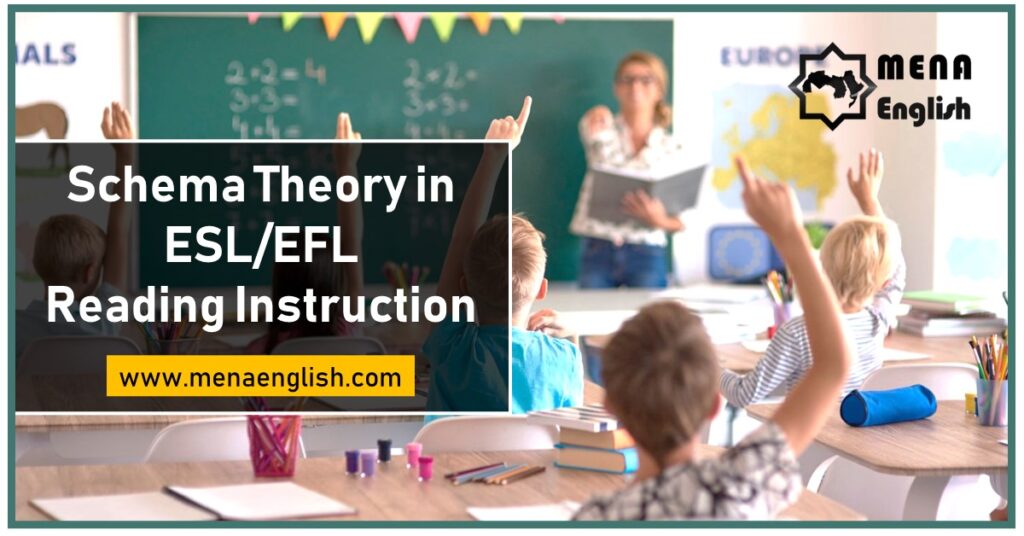
In setting out to explore the schema theory in reading in general and EFL/ESL reading instruction in particular, it should first be assumed that the notion of “background knowledge” is not something new in reading and comprehension. Kant (1763) once believed that:
‘‘New information, new concepts, new ideas can have meaning only when they can be related to something the individual already knows’’ (as cited in Carrell and Eisterhold, 1983, p 553).
Later, Anderson et al (1977) asserted that “every act of comprehension involves one’s knowledge of the world as well” (p.369). Interestingly enough, research has proved Kant and Anderson’s claims to be valid. However, with the traditional models of reading, there was an extensive focus on the language at the expense of the comprehender.
Goodman (1967, 1971, 1973), a key figure in the psycholinguistic model of reading, believes that “reading is a guessing game”. That is, the reader reconstructs the message which has been encoded as a graphic display. In so doing, s/he does not use all the provided textual cues to predict the language structure but rather selects what is enough thanks to his background knowledge about the language. Coady (1977) has elaborated on Goodman’s basic model and suggested that ESL/EFL readers can arrive at comprehension when their background knowledge interacts with conceptual abilities and process strategies. By conceptual abilities, Coady (1977) means intellectual general capacity or one’s knowledge of different concepts, whereas process strategies are subcomponents of reading, including linguistic ability, one’s knowledge of syntax, phonology, etc.
In talking about the importance of background knowledge, especially the culturally-specific type, Cody noticed that students with a western background are likely to learn English faster. Moreover, he believes that background knowledge can compensate for syntactic deficiencies, especially when students’ reading is fluency-oriented (i.e., they are reading for meaning). However, Carrell and Eisterhold (1983) believe that background knowledge is still poorly addressed in the psycholinguistic model of reading. In this regard, Clarke and Silberstein (1977) stated that,
“Readers understand what they read because they are able to take the stimulus beyond its graphic representation and assign its membership to an appropriate group of concepts already stored in their memories.” (p. 136).
That is, the background knowledge is still taken generally, which may render it vague. Assigning what the reader reads to “an appropriate group of concepts already stored in their memories” purports that background knowledge has to be redefined so that it does not remain loose, and that is what schema theory has partly come to address.
The term Schema was first used in psychology by Barlett (1932) who defined it as “an active organisation of past reactions or experiences” (p. 201). The fundamental principle of Schema theory assumes that text does not carry meaning by itself. In other words, the text does not mainly tell what to understand but rather how to understand, by proving directions, which may be interpreted inappropriately in some cases. Unlike the psycholinguistic model of reading, the Schema theory distinguishes between background knowledge and schemata. Background knowledge refers to previously acquired knowledge, whereas schemata is previously acquired knowledge structures. Accordingly, schemata is part of background knowledge. That is why it is precise to say ‘activating the schemata’ instead of ‘activating the background knowledge’ as reading instructors activate only a small part of the learners’ background knowledge needed for a better understanding of a certain text.
In the process of understanding, “every input is mapped against some existing schema and that all aspects of that schema must be compatible with the input information” (Carrell and Eisterhold, 1983, p.557). For this to happen, bottom-up and top-down processes are brought into play. In bottom-up processing, the new input travels into the best-fitting bottom-level schemata, and then high-level schemata will be activated as a result. Top-down processing, on the other hand, involves making general predictions so as that the input fits into the schemata. In other words, bottom-up processing is data-driven; it brings the necessary schemata to life, while top-down processing facilitates assimilation. In bottom-up processing, the reader can be sensitive to novel data, but top-down processing helps solve ambiguities. Herein, it should be noted that schemata is hierarchically organised. That is, general information and specific information are at the top and bottom respectively.
Here are some instances in which the two aforementioned processes interact together so that the reader/listener arrives at an appropriate understanding of a given text. In examples like: “The policeman held up his hand and stopped the car”, the reader knows that there was no physical contact between the policeman’s hand and the car thanks to the top-down processing that informs the reader that there is a conventional silent language that both the policeman and the driver understand. On the contrary, in this example: “Superman held his hand and stopped the car”, the reader can easily come to the conclusion that there was physical contact between Superman’s hand and the car although the text does not clearly indicate that. (Carrell & Eisterhold, 1983, p.557) For further illustration, they also presented this example:
“Mary heard the ice cream man coming down the street. She remembered her birthday money and rushed into the house…”.
From this text, the reader can infer many unsaid things like the fact that Mary is a kid and that she dashed home to fetch the money to buy ice cream, but when s/he encounters the completion of the text as “…and locked the door”, a mismatch between the bottom-up and the top-down processes is detected, and the reader is therefore forced to revise his interpretation.
Carrell and Eisterhold (1983) identified two types of schemata: formal schemata and content schemata. The former is the reader’s knowledge of different genres and different texts, whereas the latter refers to what extent the reader is familiar with the content area of the text (culture, sport, science, or something of one’s interest). A teacher, for instance, can distinguish between his/her students’ pieces of writing without having to look at their names thanks to the formal schemata s/he has developed about the way they write. Given this, non-understanding can happen when (1) there is a failure in activating the appropriate schemata (formal or content) and (2) when the reader does not possess an appropriate schemata anticipated by the writer (cultural-specific knowledge, for example). In this regard, Johnson (1982) pointed out that a text on a familiar topic is better recalled by ESL readers than a similar text on an unfamiliar topic.
Formal and content schema have a pivotal role in ESL/EFL reading (Hinds, 1983). In a study conducted by Carrell (1981), two groups of university ESL students were assigned two types of stories to read; one type of the stories respects the typical story structure while the other violates it. The results revealed that when the structurally-broken stories were processed, the recall was affected.
In ESL/EFL classrooms, instructors should first make sure the texts make sense to the learners before they resettle to activate a certain schemata as accessing an appropriate content schema depends initially on textual cues. Moreover, the background knowledge that L2 learners bring to the text is often culture-specific. That is, if they do not possess the corresponding culture-specific schemata, non-comprehension is likely to happen. Rivers (1986) also noted that differences in values and attitudes are one of the main sources of problems in foreign language learning.
For a better understanding of the assigned texts on the part of learners, instructors are advised to explain high-frequent but culturally-loaded terms (Rivers & Temperley, 1978). The word ‘marriage’, for instance, is a quite frequent word but can be a culturally-loaded term in the sense that it can refer to same-sex marriage, which is not conventional in some contexts. Covert information can also pose problems in reading, and texts are likely to be misinterpreted. When covert information is assumed by the writer, it must be supplied by the reader. There is, however, a risk that the reader compensates for the assumed information erroneously. Carrell and Baudouin (1977) illustrated the ambiguities a text can generate when information is covered through the following example:
“I saw the clock of the city jail that it was past eleven, so I decided to go to the newspaper immediately” (p. 83)
If students stumble upon the sentences above in the middle of a reading text, they may not be certain if the writer saw the clock from inside or outside the prison unless it is made clear before they start reading. This ambiguity can cause problems if students are assessed on the text and the comprehension questions revolve around the covert information that is assumed by the writer. What we can take from this is that instructors should be sensitive to reading difficulties caused by social-cultural meaning, culture-specific values, and covert information.
Teachers can provide learners with help in reading whether by focusing on the text or the reader. Here are some suggested approaches for better reading instruction:
- The language Experience Approach encourages students to dictate their ideas to the teacher who acts as a scribe. After the text is edited and rectified by the teacher, the learners can read their ideas in different words. This approach saves both teachers and learners the effort of activating the content and formal schema;
- Narrow reading is resorted to in order to avoid problems caused by the need for content schemata. Learners are assigned texts based on limited topics. They can also read for specific authors to develop a particular schemata that helps them with most of the reading along the way;
- Local setting-based texts can be helpful in lessening the reading deficiencies caused by culture-specific content;
- Sustained Silent Reading (SSR) is based on the idea that students can do better in reading once they select the texts they are interested in and self-direct their tasks.
Instructors can also guide learners in reading in different ways: (1) by providing background knowledge, (2) previewing the content to be read, or (3) analysing students’ needs in reading instruction and using their feedback to improve the reading course.
References:
Anderson, R. C., Reynolds, R. E., Schallert, D. L., & Goetz, E. T. (1977, November). Frameworks for Comprehending Discourse. American Educational Research Journal, 14(4), 367–381. https://doi.org/10.3102/00028312014004367
Bartlett, F. C. (1932). Remembering: a study in experimental and social psychology. Cambridge: Cambridge University Press.
Carrell, P. L. (1981b). The Role of Schemata in L2 Comprehension. Paper presented at the 15th Annual TESOL Convention, Detroit, Michigan, March, 1981.
Carrell, P. L., & Eisterhold, J. C. (1983). Schema Theory and ESL Reading Pedagogy. TESOL Quarterly, 17(4), 553. doi: 10.2307/358661
Coady, J. (1979). A Psycholinguistic Model of the ESL Reader. In Reading in a second language, Ronald Mackay, Bruce Barkman, and R. R. Jordan(Eds.), 5-12. Rowley, Massachusetts: Newbury House Publishers.
Clarke, M. A. & Silberstein S. (1977). Toward a Realization of Psycholinguistic Principles in the ESL reading class. Language Learning 27(1):135-154.
Goodman, K. S. (1967). Reading: a Psycholinguistic Guessing game. Journal of the Reading Specialist 6(1):126-135.
Goodman, K. S. (1971. Psycholinguistic Universals in the Reading process. In The psychology of second language learning, Paul Pimsleur and Terence Quinn (Eds.), 135-142. Cambridge: Cambridge University Press.
Goodman, K. S. (1973a). On the Psycholinguistic Method of Teaching Reading. In Psycholinguistics and reading, Frank Smith (Ed.), 177-182. New York: Holt, Rinehart and Winston.
Hinds, J. (1983). Retention of Information Using a Japanese Style of Presentation. Paper presented at the 17th Annual TESOL Convention, Toronto, Canada, March, 1983.
Johnson, P. (1982. Effects on Reading Comprehension of Building Background Knowledge. TESOL Quarterly 16(4):503-516.
Rivers, W. M. (1968). Teaching Foreign Language Skills. Chicago: University of Chicago Press.
Rivers, W. M. & Temperley, M. S. (1978). A Practical Guide to the Teaching of English as a Second or Foreign Language. New York: OxfordUniversity Press.
